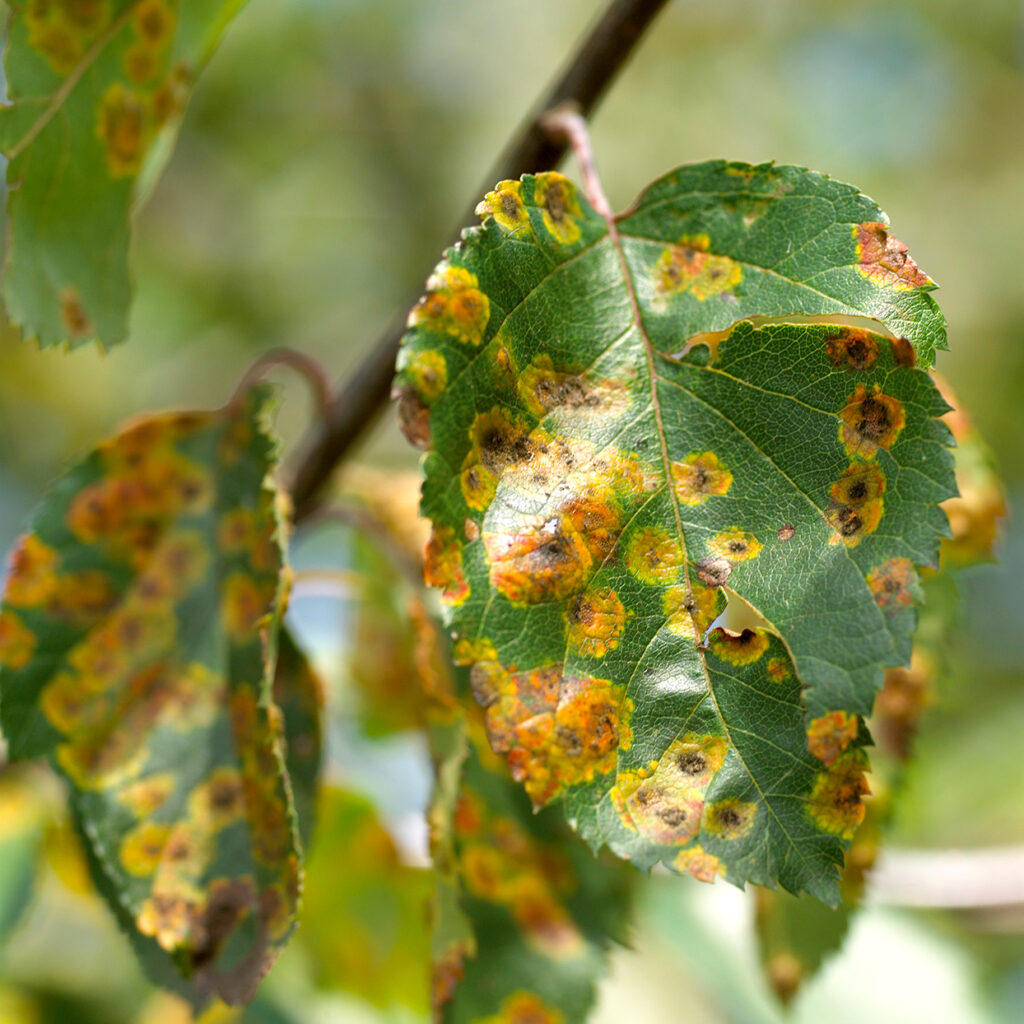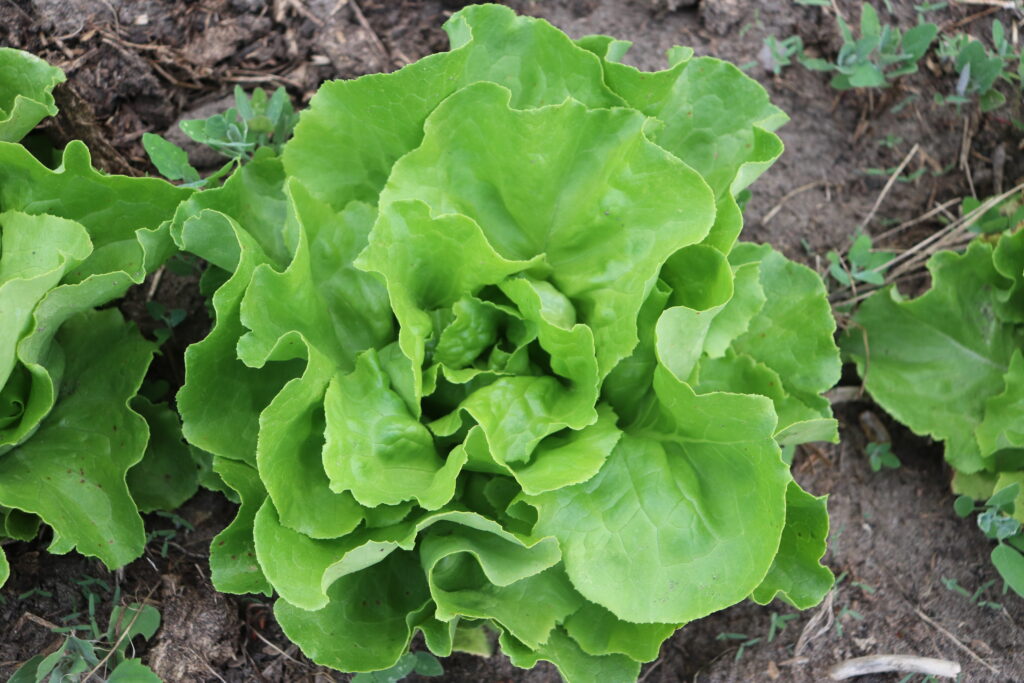
Summer is finally here and the heat and humidity are helping our gardens grow quickly. Unfortunately, this is when trouble can get a foothold, so be watchful for evidence of pests and pathogens attacking your gardens.
Watch for these common Pests and Pathogens for June/July
Rusts are now active due to the hot humid weather.

- How to recognize Rusts – They overwinter on host plants, such as junipers, and then sporulate infecting plants such as apples, crab apples, serviceberry and hawthorns, and especially cedar trees. They are reddish-orange spore masses usually found on the surface of lower leaves and stems.
- What is attacked? This fungal disease attacks roses, hollyhocks, snapdragons, daylilies, beans, tomatoes, and also lawns. When it is severe it can deform leaves and turn them yellow; eventually, the leaf will drop.
- How to Treat Rusts? Pick off and destroy infected leaves ( not in the compost). Water in the morning, trying to keep leaves dry. Using soaker hoses is helpful. Apply mulch to prevent spores from splashing up onto the leaves. Ensure your plants aren’t too crowded. Good air circulation will allow plants to dry better. Avoid excess nitrogen as soft new growth is the most susceptible. In more severe cases you may want to treat with copper sprays or sulfur powders.
Leaf spots are showing up on deciduous flowering shrubs now.

- How to recognize Leaf Spots? This is a bigger problem this year because of the cool, wet weather we had earlier when leaves were just emerging. The spots look purplish to brown with yellow to brown margins. They can get larger and larger causing leaves to turn yellow and eventually drop.
- What is attacked? Leaf spots attack poplar and aspen trees, stone fruit trees ( cherry, plum, peach), and flowers such as geraniums, zinnias, purple coneflowers, and black-eyed susans. Strawberries and vegetables such as tomatoes, peppers, lettuce, and brassicas ( cabbage, turnip, broccoli, kale, etc) may also be infected.
- How to Treat Leaf Spots – Keep soil under plants clean. Use mulch to prevent the pathogen from splashing up onto the plant. Ensure good air circulation by pruning and staking plants. Ensure that your vegetable seeds or transplants are from leaf spot-free stock. In severe cases spray with a baking soda solution, sulfur or copper fungicide, or neem oil. “Serenade Garden Spray” contains Bacillus subtillis and will safely treat most fungal and bacterial diseases. it is also nontoxic to beneficial insects.
Fireblight

- How to recognize Fireblight? This bacterial disease causes twig and branches to die back and can cause cankers on large limbs as well as the main stem.
- What is infected? Fireblight infects apple and pear trees as well as mountain ash.
- How to treat Fireblight? Copper spray and “ Serenade” provide some protection and treatment.
Other Pests and Pathogens to Watch for in June

Now is the time to check evergreens for brown shoots on junipers that could indicate Juniper tip blight. Do not prune now that new growth has appeared as it will spread the disease. Copper spray can be used to protect new growth over the spring and summer.
 If you see “ honeydew” on your euonymus, yews, pines, or cedars it is most likely a sign of feeding by scale nymphs. You can control them using thorough sprays of Horticultural oil or insecticidal soap.
If you see “ honeydew” on your euonymus, yews, pines, or cedars it is most likely a sign of feeding by scale nymphs. You can control them using thorough sprays of Horticultural oil or insecticidal soap.
The Emerald Ash Borer is still around so check your Ash tree for dieback, vertical bark cracks, and “d” shaped exit holes. If you look up in the next few weeks you may see their tiny, bullet-shaped shadows. Injectable insecticides are the only available treatment.
 Wooly Beech Aphids are now busy feeding on the underside of leaves. They are small and green, but covered with white wooly strands and produce honeydew droplets that stick to this wool. Washing with Insecticidal soap is an effective treatment. Be sure to get the underside of the leaves.
Wooly Beech Aphids are now busy feeding on the underside of leaves. They are small and green, but covered with white wooly strands and produce honeydew droplets that stick to this wool. Washing with Insecticidal soap is an effective treatment. Be sure to get the underside of the leaves.

 Honeylocust Plant Bugs are in the nymph stage. These sucking insects can cause stunting, malformation, and yellowing of leaves. To check if your tree has any, shake new leaves over white paper or cloth. They can produce many generations in a short time period so it is best to control them now. Contact insecticides work well for control.
Honeylocust Plant Bugs are in the nymph stage. These sucking insects can cause stunting, malformation, and yellowing of leaves. To check if your tree has any, shake new leaves over white paper or cloth. They can produce many generations in a short time period so it is best to control them now. Contact insecticides work well for control.

Boxtree moths are now pupating so no control is possible.
Check if there are still any larvae ( caterpillars) feeding in which case you can spray with Bacillus T. Otherwise wait to use insecticides in late June/ early July when the 2nd generation of larvae usually appear.

 Pine Bark Adelgid look like tiny yellow nymphs. They hide, along with eggs, in small, woolly white masses between the needles. They feed on emerging foliage. Now is the time to treat them with insecticidal soap, before they cover themselves with a wooly coating.
Pine Bark Adelgid look like tiny yellow nymphs. They hide, along with eggs, in small, woolly white masses between the needles. They feed on emerging foliage. Now is the time to treat them with insecticidal soap, before they cover themselves with a wooly coating.

 If needles on your Mugo, Scots Pine, and Eastern White Pine are disappearing, it’s likely due to the Eastern pine Sawfly larvae who are actively feasting at this time. They can be identified by the long stripes down their body and can be controlled with insecticides.
If needles on your Mugo, Scots Pine, and Eastern White Pine are disappearing, it’s likely due to the Eastern pine Sawfly larvae who are actively feasting at this time. They can be identified by the long stripes down their body and can be controlled with insecticides.

 If the needle tips are turning straw-coloured it could indicate the larval stage of the yellow head spruce sawfly. Insecticidal soap can help control them but you must spray well to ensure excellent coverage.
If the needle tips are turning straw-coloured it could indicate the larval stage of the yellow head spruce sawfly. Insecticidal soap can help control them but you must spray well to ensure excellent coverage.
General tips on treatments for Pests and Pathogens:
Sulfur can be a preventive fungicide against powdery mildew, rose blackspot, rusts, and other diseases. It prevents fungal spores from germinating, so it must be applied before the disease develops for effective results. Sulfur can be purchased as a dust, wettable powder, or liquid.
Do not use sulfur when temperatures are expected to exceed 80° as it can cause plant damage. Finally, there are certain “sulfur-shy” plants (including varieties of gooseberries, currants, apricots, raspberries, and cucurbits) that should never be treated with sulfur.
Copper fungicides kill both fungi and bacteria but must be used carefully to avoid plant damage. It is often sold under the term “ Bordeaux mixture “ which combines copper sulfate with lime, making it less damaging to plants. It should not be used if the weather is hot ( 85F or above). Bordeaux mixture can be applied as a dust or liquid formulation. Some sensitive plants require diluting the product to half strength, so be sure to follow label instructions.
Horticultural oil and Neem oil work differently. They control the insects that spread the diseases rather than the disease itself. Examples of insects controlled include aphids, whiteflies, mites, thrips. Oils also work well on powdery mildew but are not as effective against leaf spot diseases. Neem oil can also be effective against the eggs of many insect pests. Many plants are sensitive to oils: black walnut maples, hickories, redbud, smoke bush, junipers, cedars, spruce, and Douglas firs. Horticultural oil should not be applied when the weather is very hot ( 90F) or cool ( below 40F).
Baking soda is often used with oil to be effective against diseases but it leaves toxic sodium behind which can harm plants. A better alternative is potassium or ammonium bicarbonate. As an added benefit these also add nitrogen and potassium which contributes to plant growth and health
Some helpful references for dealing with Pests and Pathogens:
https://onnurserycrops.com
https://www.extension.purdue.edu/extmedia/bp/bp-69-w.pdf
https://onnurserycrops.com/2021/06/04/hot-humid-days-are-here
https://www.planetnatural.com/pest-problem-solver/plant-disease/Image Credit –
Note – Image Credits
- Feature Image – Scott Little, BHG article “Diagnosing Tree Disease”
- All other images – ONnurserycrops Blog
For great images and management information on your mobile device, check out the free scouting App Bugfinder, on Apple and Google Play.
Related Posts
https://8ff.ad6.myftpupload.com/gypsy-moths-threaten-our-trees-your-help-is-needed/





About The Author: Szalich
Rosemarie holds a BSc in Agriculture and is a certified Organic Master Gardener with London Middlesex. She has gardened all her life and created a variety of landscapes and vegetable gardens in several provinces before settling in London Ontario. Currently, she is experimenting with growing vegetables in large raised planters.
More posts by Szalich